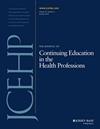三维虚拟与印刷模型在兽医学生先天性心脏病教育中的应用
IF 1.6
4区 教育学
Q2 EDUCATION, SCIENTIFIC DISCIPLINES
Journal of Continuing Education in the Health Professions
Pub Date : 2023-01-01
DOI:10.4103/ehp.ehp_28_22
引用次数: 0
摘要
简介:先天性心脏病(CHD)是一种常见的心脏缺陷,在出生时可以出现在小型和大型动物中。学生了解正常和异常心脏解剖是正确诊断和处理冠心病的必要条件。目的是在研讨会期间创建和使用三维(3D)心脏模型,以了解兽医学生对3D模型进行冠心病教育的看法。我们假设3D模型可以增强学生对冠心病的理解,并且学生在心脏教育中更喜欢3D模型。材料和方法:利用犬动脉导管未闭的计算机断层血管造影数据集建立三维模型。进行分割和计算机辅助设计。三维模型的虚拟叠加显示在二维胸片上。立体光刻文件由3D打印机制作。学生们参加了一个由2D和3D教学站组成的CHD工作坊。工作坊前后进行自我评估调查。结果:22名兽医学生参加了研讨会。根据学生的感知,3d打印模型是最有帮助的教学方式。3D打印模型(P < 0.0001)和3D数字模型(P < 0.0001)被认为比2D x线摄影站更有帮助。所有学生都强烈同意(15/22)或同意(7/22),即叠加在2D x光片上的虚拟模型增强了他们对解剖结构的空间识别。所有学生都强烈同意(17/22)和(5/22),认为CHD工作坊是一个宝贵的学习机会。结论:建立三维心脏模型是可行的。三维模型可能有助于理解胸片上心血管解剖的空间识别。我们提倡在冠心病教育中使用3D心脏模型。本文章由计算机程序翻译,如有差异,请以英文原文为准。
Utility of three-dimensional virtual and printed models for veterinary student education in congenital heart disease
Introduction: Congenital heart disease (CHD) is a common heart defect that can be present in small and large animals at birth. Student understanding of normal and abnormal cardiac anatomy is imperative for proper diagnosis and management of CHD. Objectives were to create and use three-dimensional (3D) heart models during a workshop to understand veterinary student perception of 3D models for CHD education. We hypothesized that 3D models would enhance student understanding of CHD, and students would prefer 3D models during cardiac education. Materials and Methods: Computed tomography angiography datasets from canine patent ductus arteriosus were used to create 3D models. Segmentation and computer-aided design were performed. Virtual overlays of 3D models were displayed onto two-dimensional (2D) thoracic radiographs. Stereolithography files were fabricated by a 3D printer. Students participated in a CHD workshop consisting of 2D and 3D teaching stations. Self-assessment surveys before and after the workshop were completed. Results: Twenty-two veterinary students attended the workshop. The 3D-printed models were found to be the most helpful teaching modality based on students’ perception. The 3D-printed model (P < 0.0001) and the 3D digital model (P < 0.0001) were perceived to be significantly more helpful than the 2D radiograph station. All students strongly agreed (15/22) or agreed (7/22) that virtual models overlayed onto 2D radiographs enhanced their spatial recognition of anatomic structures. All students strongly agreed (17/22) and agreed (5/22) that the CHD workshop was a valuable learning opportunity. Conclusion: Creation of virtual and fabricated 3D heart models is feasible. Three-dimensional models may be helpful when understanding spatial recognition of cardiovascular anatomy on thoracic radiographs. We advocate using 3D heart models during CHD education.
求助全文
通过发布文献求助,成功后即可免费获取论文全文。
去求助
来源期刊
CiteScore
3.00
自引率
16.70%
发文量
85
审稿时长
>12 weeks
期刊介绍:
The Journal of Continuing Education is a quarterly journal publishing articles relevant to theory, practice, and policy development for continuing education in the health sciences. The journal presents original research and essays on subjects involving the lifelong learning of professionals, with a focus on continuous quality improvement, competency assessment, and knowledge translation. It provides thoughtful advice to those who develop, conduct, and evaluate continuing education programs.

 求助内容:
求助内容: 应助结果提醒方式:
应助结果提醒方式:


